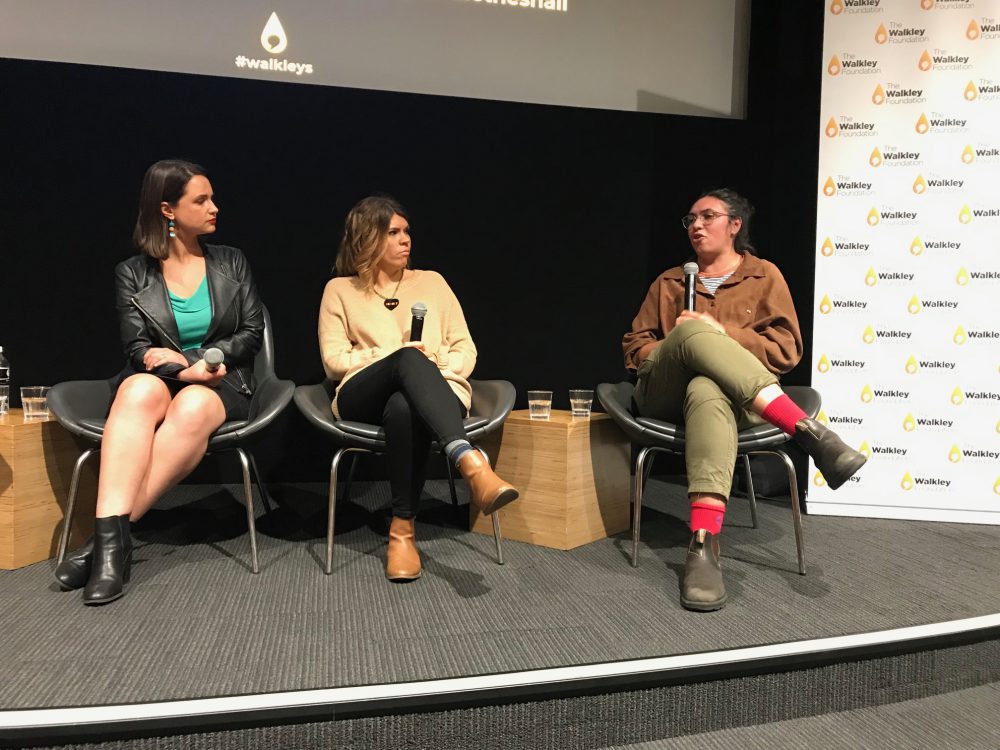“I don’t think I’ve ever worked in a newsroom where I wasn’t the only black journalist… You feel very alone in those circumstances.”
That’s the experience of Rae Johnston, editor of Junkee, and one of three First Nations media professionals who took part in a recent panel discussion, “Telling our stories: Aboriginal and Torres Strait Islander journalists”, held by the Walkley Foundation.
The tone of the discussion, which was moderated by NITV journalist and Mudburra/Maluyligal woman Natalie Ahmat, was light, but the subject matter — Indigenous representation in the media — was serious.
Shannan Dodson, Communications Manager for Indigenous Leadership and Engagement at UTS, kicked off with the simple yet inarguable point that, despite progress on black representation over the last few years, “it’s not good enough”.
Walkley Award-winning ABC journalist Yale Macgillivray nodded in agreement, and Dodson’s sentiments were echoed by Johnston, a Wiradjuri woman and a science and technology specialist.

While there is room for improvement on diversity in every profession, it is particularly important in journalism, because, as Johnston pointed out, there is a gaping hole in the quality of media content and “audiences are missing out”.
She told the audience at the New South Wales State Library: “If you want to get the truth about Indigenous people in this country, you’re only really going to get that from having black journalists in these newsrooms.”
The continuing lack of diversity in newsrooms across the country is staggering. A 2016 study by PwC found that the average employee in the media and entertainment industries is English-speaking, male, Caucasian, aged 27, and from Sydney’s Inner-West or Eastern Suburbs.
The impact of under-representation has been felt by the panel members, who discussed their frustration at being “pigeonholed”, often as Indigenous affairs experts, and “exploited” as a resource on all things Indigenous within their workplaces.
Dodson, a Yawuru woman, said she was constantly asked for advice and essentially did “hours and hours of unpaid work”.
Johnston commented, wryly: “At one point I did want to print up a T-shirt that just said ‘Aboriginal Google’”.
Johnston has had an unusual career trajectory, starting off writing about video games, then moving into the science and technology space. She was editor of Gizmodo, presented a segment on video games on Triple J, and has been a presenter on SBS and NITV.
As an Indigenous woman, she is a rarity in her specialist area, and believes she brings a unique perspective to science and technology.
Macgillivray suggested that, rather than always seeking information from the one black journalist in the newsroom, employers should hire consultants to advise them on cultural sensitivity.
“How about we start putting some education in place… stop being defensive about these situations?” she said. “Because they can be resolved, but that’s the only way it’s going to happen.”

Cultural sensitivity training is increasingly important for mainstream journalists and media organisations, particularly to guide them when posting stories on social media, the panellists believe.
As editor of Gizmo, Rae closely moderated comments appearing beneath Indigenous science and other stories, many of which were racist.
She said that “my heart would sink” when she scanned the comments section.
Johnston eventually decided to deactivate the section, in order to create a healthier work environment.
“It was the best thing I ever did,” she said.
Despite that negativity, social media has had a positive impact on Indigenous people and communities, according to the panellists, allowing those who are not usually in the spotlight to have a voice and give their opinion.
Macgillivray, a Kalkadoon and South Sea Islander woman, and digital producer of the award-winning Blood on the Tracks podcast, said social media also provided a “mending bridge” to connect and share stories.
“You really see … the beautiful culture that is Aboriginal and Torres Strait Islander culture in these social video clips or articles.”
The panellists believe, however, that regardless of the platform that social media can provide, it is vital that mainstream media organisations employ more Indigenous journalists and place them in positions of influence.
Johnston observed that, without Indigenous decision-makers, editors, CEOs, producers and publishers, there was far less chance that Aboriginal stories would be handled well.
“People want to see themselves in media,” she said.
“They want to see themselves represented, their stories represented and told the right way.”- @caitlinmccor1


